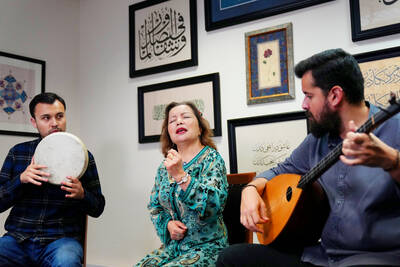Mattel has launched a new line of black Barbie dolls with fuller lips, a wider nose and more pronounced cheek bones — a far cry from Christie, Barbie’s black friend who debuted in the 1960s and was essentially a white doll painted brown.
The So In Style line, which hit mass retailers last month, features BFFs Grace, Kara and Trichelle, each with her own style and interests and a little sister she mentors: Courtney, Janessa and Kianna. The dolls reflect varying skin tones — light brown, chocolate, and caramel — and Trichelle and Kianna have curlier hair.
Barbie designer Stacey McBride-Irby, who is black and has a six-year-old daughter, said she wanted to create a line of dolls for young black girls that looked like them and were inspirational and career-minded. For example, Kara is interested in math and music.
“I want them to see themselves within these dolls, and let them know that black is beautiful,” she said.
Many black women are praising Mattel for its efforts — Black Barbie hit the shelves in 1980 with white features shared by many of the dolls following her.
But some say the dolls with long straight hair are not “black enough” and do not address the beauty issues that many black girls struggle with. In the black community, long, straight hair is often considered more beautiful than short kinky hair.
Chris Rock highlights the issue in his Good Hair documentary, which opened in select US cities on Friday and shows black women straightening their tight curls with harsh chemicals and purchasing US$1,000 hair weaves.
“Why are we always pushing this standard of long hair on our girls?” asked Gail Parrish, 60, a playwright in Alexandria, Virginia, and a mother of four grown children. “Why couldn’t one of the dolls have a little short Afro, or shorter braids or something?” McBride-Irby said she originally designed all the dolls with long hair. Combing her Barbie’s long hair when she was a girl was the “highlight of my play experience,” she said. She was advised to create some dolls with curlier hair, so she did.
There is a So In Style hairstyling set so girls can curl, straighten and style their dolls’ hair over and over. (It costs US$24.99, more than a pair of dolls at US$19.99.)
That is troubling to Sheri Parks, an associate professor of American Studies at the University of Maryland in College Park, because it actively involves girls in the process of straightening hair. She worries that it reinforces the message that there is something wrong with natural hair.
“Black mothers who want their girls to love their natural hair have an uphill battle and these dolls could make it harder,” Parks said in an e-mail.
Aside from the hair, some black women are concerned about the dolls’ thin frames. Barbie, which celebrated her 50th birthday in March, has for years come under fire for promoting an unrealistic body image, with her long legs, tiny waist and large breasts.
While white girls also deal with body-image issues, Kumea Shorter-Gooden, co-author of Shifting: The Double Lives of Black Women in America, believes Barbie has a more negative impact on black girls. They are already struggling with messages that “black skin isn’t pretty and our hair is too kinky and short,” she said.
Despite those complaints, Mattel seems to have gotten several things right.
Andrea Slaughter, 38, a mom of two in Newnan, Georgia, said she likes how the designer highlighted values that are critical in the black community, such as education and mentoring.
Sheila Adams Gardner, 41, a mother of three in Woodbridge, Virginia, praised the varying skin tones. She said when her daughter was 4, she became very self-conscious about being lighter than everyone else in her family.
“She has always had African-American dolls, but rarely dolls with skin like her own,” she said. “Often the lighter dolls were Hispanic or Indian. It was very heartwarming to look at a series of African-American Barbies and hear my daughter, now 11, exclaim, ‘She looks like me!’” Even Shorter-Gooden acknowledged the facial features “look like real black people.” Mattel doesn’t release sales figures. But Michelle Chidoni of Mattel said the dolls are resonating with girls of all colors and ages.
The line will be expanding next year with Rocawear clothing, new dolls Chandra and her little sister Zahara, and Darren, who will have a little brother he mentors.

This is the year that the demographic crisis will begin to impact people’s lives. This will create pressures on treatment and hiring of foreigners. Regardless of whatever technological breakthroughs happen, the real value will come from digesting and productively applying existing technologies in new and creative ways. INTRODUCING BASIC SERVICES BREAKDOWNS At some point soon, we will begin to witness a breakdown in basic services. Initially, it will be limited and sporadic, but the frequency and newsworthiness of the incidents will only continue to accelerate dramatically in the coming years. Here in central Taiwan, many basic services are severely understaffed, and

It is a soulful folk song, filled with feeling and history: A love-stricken young man tells God about his hopes and dreams of happiness. Generations of Uighurs, the Turkic ethnic minority in China’s Xinjiang region, have played it at parties and weddings. But today, if they download it, play it or share it online, they risk ending up in prison. Besh pede, a popular Uighur folk ballad, is among dozens of Uighur-language songs that have been deemed “problematic” by Xinjiang authorities, according to a recording of a meeting held by police and other local officials in the historic city of Kashgar in

Jan. 5 to Jan. 11 Of the more than 3,000km of sugar railway that once criss-crossed central and southern Taiwan, just 16.1km remain in operation today. By the time Dafydd Fell began photographing the network in earnest in 1994, it was already well past its heyday. The system had been significantly cut back, leaving behind abandoned stations, rusting rolling stock and crumbling facilities. This reduction continued during the five years of his documentation, adding urgency to his task. As passenger services had already ceased by then, Fell had to wait for the sugarcane harvest season each year, which typically ran from

The People’s Republic of China (PRC) was out in force in the Taiwan Strait this week, threatening Taiwan with live-fire exercises, aircraft incursions and tedious claims to ownership. The reaction to the PRC’s blockade and decapitation strike exercises offer numerous lessons, if only we are willing to be taught. Reading the commentary on PRC behavior is like reading Bible interpretation across a range of Christian denominations: the text is recast to mean what the interpreter wants it to mean. Many PRC believers contended that the drills, obviously scheduled in advance, were aimed at the recent arms offer to Taiwan by the